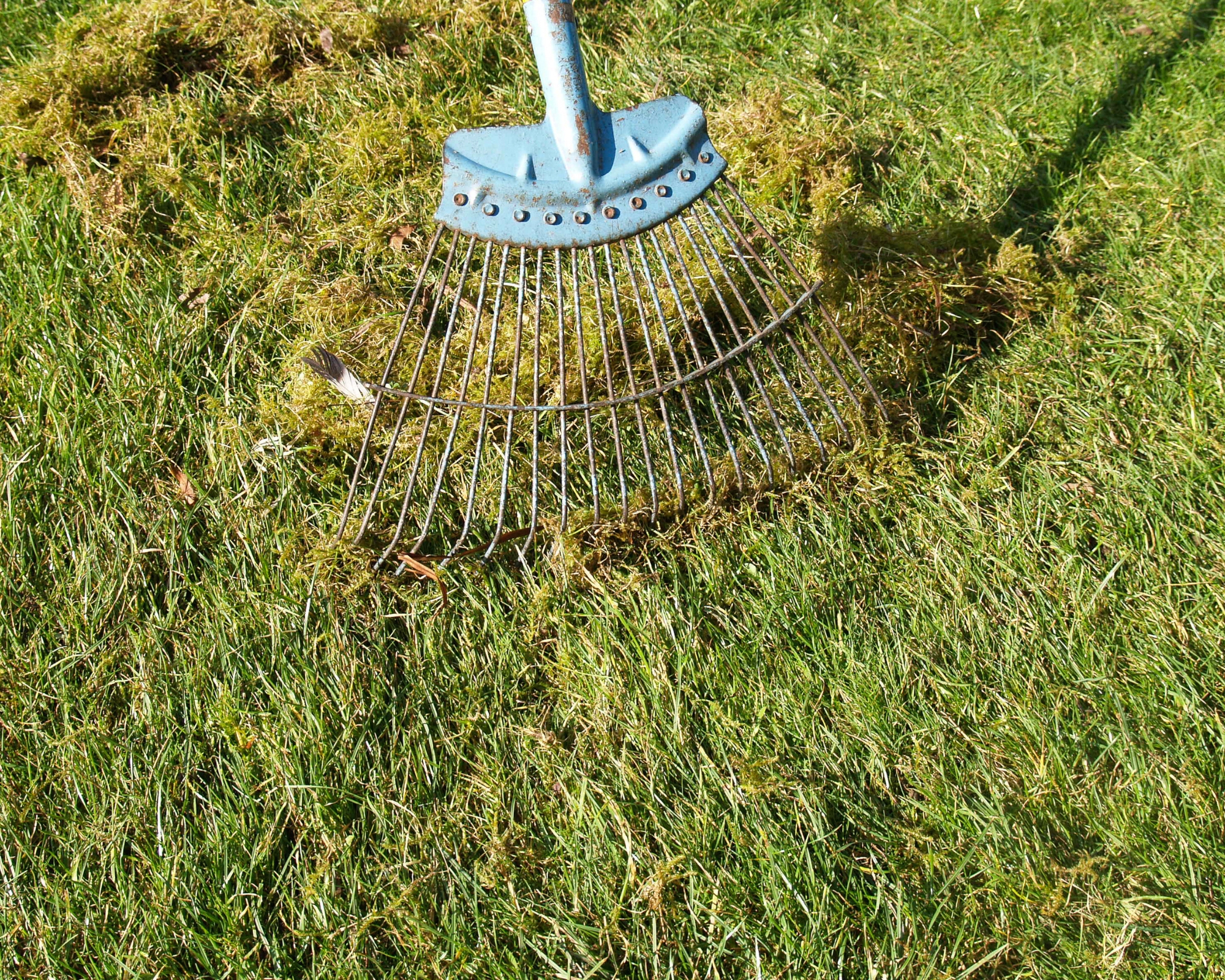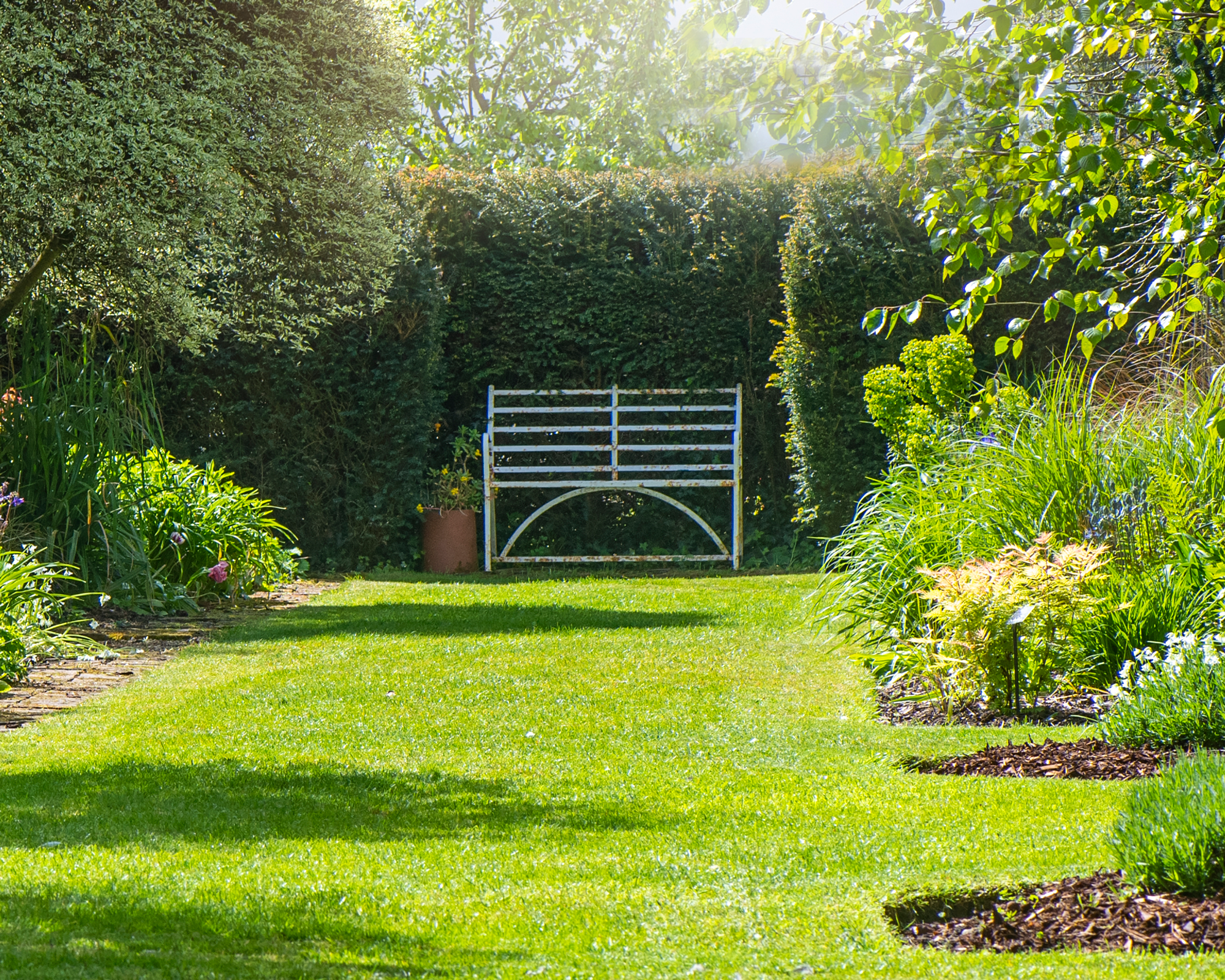
Great lawn care is the key to achieving a lush lawn you and your guests can savour.
From mowing advice to weed control, our garden pros reveal the 11 simple steps they take to help their clients (and themselves) keep a healthy, happy and luscious lawn on the go year-round.
When it comes to beautiful backyard ideas, we'd argue it all starts with a fabulous lawn.
11 Lawn tips from the pros
Combining great landscaping ideas with high-quality lawn care will really make the most of your garden. From aeration to fertilization, our green-thumbed experts will walk you through 11 tips for lawn care, with step-by-step instructions to master each stage.
Where our pros have suggested products, we've sourced high-quality items from trusted retailers.
All prices were correct at the time of publication.
1. Water your lawn in the morning

When it comes to top-quality lawn care, timing is everything. Since mowing in the heat is among the most common mowing mistakes, and doing it in the evening has its downsides too, a morning mow is your ticket to a healthy lawn.
Jeremy Yamaguchi, CEO of Lawn Love, says, "During the summer, you want to aim to only water your lawn in the morning, ideally before 10 or 11 am depending on your climate.
"Once the temperature heats up, water evaporates quickly meaning your lawn is getting less and you're wasting more water for the same effect. Or, if your sprinklers are automated, your grass isn't getting enough water."
Watering in the morning gives grass blades time to dry before evening, reducing the risk of fungal diseases and weeds that both thrive in damp conditions.
Jeremy adds, "Standing water overnight can increase the chance for grass or soil diseases — not to mention pest problems. That's why I'd recommend avoiding the evening as well."
It's good to know many species of ants need water for nesting and therefore having water pooling on your lawn overnight will make it harder to get rid of ants.
2. Fertilize your lawn strategically
Fertilizing your lawn is crucial for providing the nutrients it needs to thrive. However, it’s important to apply fertilizer strategically.
Jeremy says, "Fertilizing plays a crucial role in your summer lawn care schedule. By fertilizing your lawn, you can promote healthier, more lush-looking grass in just weeks.
"However, with fertilizer, too much is not a good thing. If your lawn looks like it’s struggling, don’t be tempted to over-fertilize to save it. Yes — fertilizing your grass is one of the easiest ways to give the soil nutrients and promote growth. However, over-fertilizing can have the opposite effect you’re looking for.
"If you over-fertilize your lawn, you may 'burn' your grass and cause permanent damage. Instead, it’s essential to find the recommended amount of fertilizer for your yard’s grass type and apply it accordingly."
Scotts Green Max Lawn Food from Amazon can cover 5,000 square feet and contains 5% iron to enhance the greening process.
Fertilizing your lawn will also help keep weeds from taking hold, and you can double up the process with a weed and feed product such as Scott's Weed and Feed available on Amazon, as recommended by our experts, to kill weeds and fertilize your lawn at the same time. Learn more ways to kill weeds.
3. Sharpen the lawn mower blades

A clean cut is essential for maintaining healthy grass. Dull mower blades tear the grass, causing jagged edges that can turn brown and invite disease and also increasing the risk of pulling out your grass instead of giving it a little off the top.
Ryan Farley, chief executive officer of LawnStarter, says, "With sharp blades, your grass can get a healthy and clean cut, whereas with dull blades, your lawn can start looking less than its best, turning sickly and brown.
"The reason is that while sharp blades effectively slice off the top portion of grass blades, dull blades rip and tear away the grass, which causes stress to the grass and makes it more susceptible to diseases."
Sharpen your mower blades at least once a season, or more often if you notice the grass looks ragged after mowing.
Ryan adds, "The best way to sharpen lawnmower blades is to use a 10-inch file or grindstone. Wearing protective gear, hold the file at a 45-degree angle and start from the top of the blade. Don't slide the file back and forth — push down in one direction, place the file at the starting point, and repeat."
This Uxcel Diamond Coated 10-inch File from Walmart is water-resistant and has a plastic, anti-slip handle.
Learn how to sharpen lawnmower blades safely in our expert-led guide.
4. Mow the grass high
Setting your mower blades higher helps maintain a healthy lawn.
Ryan says, "Mowing your grass to be a little taller encourages strong root growth, which in turn helps your lawn become more drought-resistant and heat-tolerant, so it will benefit your lawn all summer and in the future.
"For warm-season grasses, aim to set your mowing height 2-3 inches high, and for cool-season grasses, aim to set your mowing height to no shorter than three inches tall. This will also impact how often you mow.
"Ideally, when you mow, you don’t want to take off more than a third of your grass blades’ height, because any more than that can cause stress to the turf."
Check out our guides to the best lawn mowers, or — for small gardens — the best lawn mower for tiny outdoor spaces to help pick the right mower for you.
5. Avoid overwatering the lawn

While it’s important to keep your lawn hydrated, over-watering can be just as harmful as under-watering.
Ryan says, "During the hottest months of the year, people often make the mistake of watering their lawns too much. Ideally, when you water your lawn, you want the water to go 6-8 inches deep into the soil.
"To figure out if you’re over or under-watering your lawn, take a long screwdriver and drive it into the soil. If the soil is dry and you’re having a tough time getting it through, then you’re probably under-watering. If it slips right in, you’re over-watering."
Too much water can lead to shallow root growth, making your lawn more susceptible to drought and disease. It can also encourage the growth of weeds and fungi. Investing in a rain gauge (such as this Taylor Precision Products Rain and Sprinkler Gauge from Target) and soil moisture sensor (like this XLUX Soil Moisture Meter from Amazon) can help you better manage your lawn’s water needs.
Ryan adds, "Remember that it's better to water deeper but less frequently compared to shallower and everyday because it encourages stronger root growth. Even in the hottest, driest areas, you typically don’t need to water every day. Pay attention to the weather as well — if it rains, you don't want to be mowing your lawn the next day."
6. Control weeds
Weeds compete with your grass for nutrients, water, and sunlight, so avoiding weeding mistakes and keeping them under control is essential for a healthy lawn.
Zahid Adnan, founder of The Plant Bible, says, "Effective weed control is key to maintaining optimal lawn health and aesthetics. Begin by identifying the type of weeds present in your lawn, then apply a pre-emergent herbicide to prevent weed seeds from germinating."
Zahid recommends Preen Weed Control and Lawn Care from Amazon which kills up to 250 types of weed including thistle and chickweed.
He adds, "For existing weeds, use post-emergent herbicides, or pull weeds manually, ensuring you remove the entire root. By reducing competition, grass can access more resources for healthy growth."
This Spectracide Weed Stop from Target kills more than 470 weed-types without damaging your lawn and is a safe bet but check which type of grass you have before applying any wide-spectrum herbicide.

Price: Was $35.99, now $29.99
Size (inches): 39.5H x 9.5W x 2.5D
This long-armed weeder is made of durable, rust-resistant stainless steel — among the best outdoor materials you can buy. At 39 inches, it helps avoid back ache while the long handle allows a solid grip. The spiky end is effective on multiple weed types including dandelions.

Prices: From $9.99 (pack of two)
Sizes: Small, medium, and large
Safe for humans and the environment, as certified by OEKO-TEX STANDARD 100, these lightweight COOLJOB Gardening Gloves are created with a sturdy, foamed, breathable, latex coating. Expect an excellent grip, super stretchy base, and cute color options to boot.

Price: Was $33.29, now $20.99
Dimensions (in.): 17.5 x 11 x 1.5
This Gorilla Grip Extra Thick Kneeling Pad offers comfort without slippage when gardening, alleviating joint aches during lengthy gardening tasks. With 21,500 reviews and an average 4.6/5 stars given by happy customers, thousands of keen gardeners approve.
7. Aerate the lawn
Aeration involves perforating the soil with small holes to allow air, water, and nutrients to penetrate the grass roots. This process helps alleviate soil compaction, which can restrict root growth and lead to a less vigorous lawn.
Zahid says, "Aeration promotes a healthier root system and helps to break down thatch. It's best done in the fall or spring when your grass is actively growing.
"Use a core aerator, which removes small plugs of soil from the lawn, making multiple passes over the lawn to ensure even coverage. Leave the soil plugs on the lawn to decompose naturally."
Aerating your lawn once a year can significantly improve your lawn’s health and resilience. Zahid recommends the vanpein Lawn Aerator Coring Garden Tool from Amazon, particularly for smaller areas or spot treatments.
8. Dethatch the lawn

Thatch is a layer of dead grass, roots, and other organic material that can build up between the soil and the grass blades. While a small amount of thatch is normal, excessive thatch can prevent water, nutrients, and air from reaching the soil.
To dethatch your lawn, use a dethatching rake or a power dethatcher to remove the excess material. As with aeration, this process is best done in the late spring or early fall when the grass is actively growing. After dethatching, water and fertilize your lawn to help it recover and fill in any bare spots.
Rafi Friedman, chief executive officer of Coastal Luxury Outdoors, says, "Dethatching and aerating keeps your lawn from crowding itself out and allows for much better water flow and drainage, so I'd highly recommend getting your lawn thatched and aerated once a year.
"If you're on top of everything else — regular mowing, the right mix of fertilizer, and a proactive approach to weed control — this is the key difference between a good lawn and a great lawn."
This Walensee 15-Inch Lawn Dethatching Rake from Walmart has 19 curved steel tines (prong) to penetrate beneath the surface. For an electric option, this SWIPESMITH 15-Amp Electric Dethatcher from Amazon comes with a special scarifying blade.
9. Overseed bare patches
Bare patches in your lawn can be unsightly and invite weed growth. Overseeding is the process of planting new grass seed in these areas to promote a fuller, healthier lawn.
Start by preparing the soil by raking away debris and loosening the top layer. Choose a grass seed that matches your existing lawn and spread it evenly over the bare spots. Lightly rake the seeds into the soil and water regularly to keep the area moist until the new grass establishes.
Overseeding in the fall or spring is ideal, as cooler temperatures and more frequent rainfall support seed germination and growth.
10. Keep the lawn edges neat

Neat lawn edges can significantly enhance the overall appearance of your lawn. Use a string trimmer or edging tool to create clean, defined borders along driveways, walkways, and flower beds.
Regular edging prevents grass from encroaching on these areas and gives your lawn a polished, well-maintained look. Make it a habit to edge your lawn every time you mow, and remove any grass clippings or debris from the edges to maintain a tidy appearance.
This Black & Decker Edgehog from Target has a 12-amp high torque motor and three blade position options to get around corners or fussy areas of landscaping.
11. Create a pet bathroom

If you're taking all this time and care over your lawn, the last thing you want is for it be spoiled — literally — by your pets.
Jeremy says, "Cat or dog urine can lead to dead grass and brown patches, plus during the summer you may want to be able to walk or lay in your grass without worrying about what you might step in."
Create a designated doggy bathroom area using gravel, mulch, or artificial turf to minimize damage to your lawn. Train your pets to use this area by taking them to the spot consistently and rewarding them when they go there. This practice helps reduce urine spots on your grass, which can cause yellow or brown patches due to the high nitrogen content.
Jeremy adds, "By sectioning off a small section of your yard as a dedicated pet bathroom, and training them to only use that area, you can keep your lawn much healthier."
If your dog or cat does its business before you can lead them to the dedicated spot, clear up solids quickly and pour fresh water over the area to disperse the organic material and protect your lawn.
Meet our experts
By following these 11 professional lawn care tips, you can create and maintain a vibrant, healthy lawn that thrives for many seasons to come.
Next, learn how to prepare your grass for hot weather.







